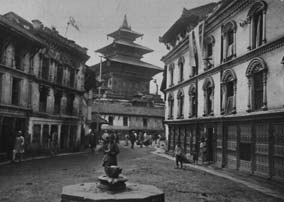|
 The last time I visited Kathmandu, I went looking for a restaurant that I had been to on several previous visits. It was called "Typical Nepali Restaurant." On my last visit the owner had told me he was trying to leave the country: "No future in Nepal" he said. So I was pessimistic about my prospects, and unfortunately (for me) I was right. I couldn't even find the building that it had been in. Old buildings are disappearing rapidly in Kathmandu. It was a disappointment. The owner had recognized me on my last visit even though I hadn't been in for several years. Imagine how cool it is to be recognized on the other side of the world. I was also disappointed because I liked the simple, traditional food that he served, and the little bowls of raksi (a strong, traditional alcoholic beverage) that he served after the meal. The last time I visited Kathmandu, I went looking for a restaurant that I had been to on several previous visits. It was called "Typical Nepali Restaurant." On my last visit the owner had told me he was trying to leave the country: "No future in Nepal" he said. So I was pessimistic about my prospects, and unfortunately (for me) I was right. I couldn't even find the building that it had been in. Old buildings are disappearing rapidly in Kathmandu. It was a disappointment. The owner had recognized me on my last visit even though I hadn't been in for several years. Imagine how cool it is to be recognized on the other side of the world. I was also disappointed because I liked the simple, traditional food that he served, and the little bowls of raksi (a strong, traditional alcoholic beverage) that he served after the meal.
But change is inevitable. On my first visit to Nepal in the early 80s, there were still a lot of traditional Nepali buildings in the Thamel backpacker ghetto. Now all you find is souless cement structures. The atmosphere is still exotic along the narrow streets filled with small souvenir shops, banners, prayer flags, etc. It is still the destination of backpackers that it has been since the late 60s. Plenty of offers of hashish as you walk along. But it is probably hard for the recent visitor to believe that 30 years ago, the streets had very few cars. You could ride a bicycle peacefully from Thamel to Pattan. Now, the city is packed with cars, buses, tuk tuks spewing black exhaust. Getting around is time consuming and frustrating. If you want a feel of the old days, head to Bhaktapur - a cleaned up, well-maintained version of Kathmandu in a not-so-distant era.
There are still blackouts like there were 30 years ago. Now, they're every day for 4 hours. There is a schedule for these "rolling blackouts." You need to know which neighborhood you're in and consult the schedule. They alternate the time block so that no neighborhood has a blackout at the same time every day. Everyone gets to share the pain. 30 years ago, it was simple. Every other night the electricity went off, so you knew you didn't want to stay in your dark hotel room. Everyone would just go to a restaurant and hang out by candlelight, swapping travel stories.
One of my favorite escapes from the hustle and bustle is the Keshar or Kaiser library. It's never been a tourist destination, even though it is directly across from the Royal Palace. It was once the home of Field Marshal Kaiser Shamsher Jung Bahadur Rana (1892-1964) - that's a mouthful. Everything is frozen in time. There are his personal photos of safaris and hunting trips. The books all date from his lifetime. It is one of the largest libraries in Nepal, but I just go for the atmosphere. No changes here! At least, not inside. But outside, yes. When I visited in the 90s there were enormous fruit bats about the size of a cat hanging from the trees in front. At dusk they'd take flight. A little spooky, but I enjoyed it. They've been gone for 15 years.
The Kaiser Library
For information on volunteer or internship programs in Nepal
By Kevin O'Neill
|